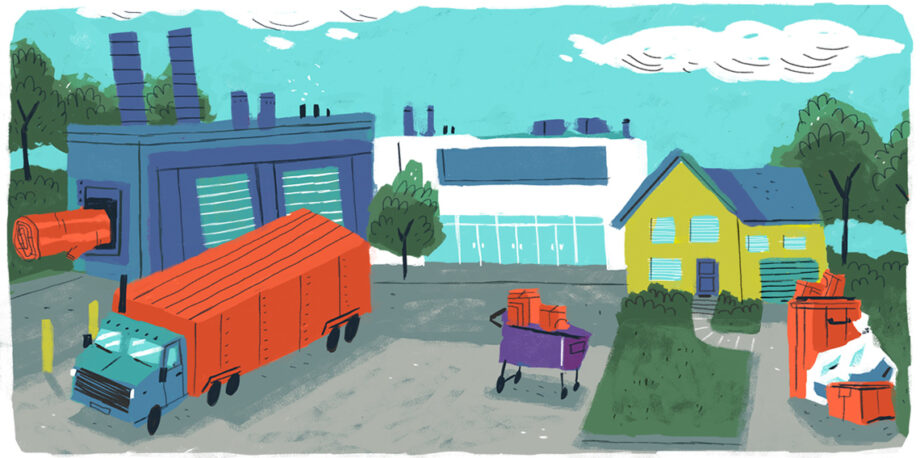July 22, 2014 — Make every decision with the future in mind. In essence, that’s the definition of sustainability. It means doing our part to ensure that our great-grandchildren — and their great-grandchildren — will have the resources they’ll need to maintain a high quality of life.
But for such a simple concept, sustainability requires considerable effort, far more than most people realize. Easy choices are propagated through advertising and media, helping consumers feel good about simple actions such as buying a hybrid SUV or using compostable cups at the coffee shop.
Such actions can offer advantages over traditional alternatives, but they’re just one piece of the sustainability puzzle. Hybrid vehicles do use less fuel per mile, but that benefit can be lost if you drive more because you have an efficient vehicle. Compostable cups are great, but only if they’re actually composted.
To truly understand the pros or cons of our decisions, we must weigh them against other options and measure impact over time. Making sustainable choices requires learning about products — where they come from, how they’re made and where they go when we’re done using them. We have to look holistically at the full life cycle.
Admittedly, having a life-cycle mind-set makes the job of being a consumer a lot more difficult. It requires research and introspection. But it can also be enlightening, opening the door to elements of a product’s impact that people never before considered. It brings much-needed clarity to the issue of personal sustainability.
While the practice of quantitative life-cycle assessment at large companies relies on abundant scientific data and number crunching, consumers can benefit from applying the underlying concepts.
For a growing number of businesses, life-cycle assessment helps direct product development from the outset. For example, at Dow, before investments are allocated toward new product production, a team examines where raw materials will come from, where products may be sold, who else participates in the supply chain and what happens at the end of a product’s life. It’s a practice that helps researchers evaluate the potential footprint of a product, compare it to alternatives and rank projects against key sustainability criteria, such as water and energy use and greenhouse gas emissions.
While the practice of quantitative life-cycle assessment at large companies relies on abundant scientific data and number crunching, consumers can benefit from applying the underlying concepts.
How does this work on a consumer level? Let’s consider the example of food packaging, because it’s prevalent in our daily lives and presents many unseen dimensions that impact sustainability.
When browsing the aisles at a grocery store with sustainability in mind, you may choose a product based on the eco-friendly labeling or decide against it if its packaging seems too bulky. Perhaps you choose glass because it’s recyclable or plastic because it’s unbreakable.
Yet, to make a truly informed decision, you can’t just focus on the moment. You need to consider the entire life cycle of the packaging and the product it contains. This includes the energy, water and other resources that went into manufacturing the packaging material. It also takes into account the energy used to transport the product to the store, because packaging influences fuel: Smaller and lighter packaging may translate into more food fitting into each truckload and lighter loads.
What’s in the package is also very important. When buying food, consider how the packaging influences the product’s lifespan when compared with alternatives. More than 1.3 billion tons of food are lost or wasted annually, according to the Food and Agriculture Organization of the United Nations. When that food goes to waste, so does the energy and water used to create it. Minimizing food waste is a severely undervalued act of sustainable living.
Every day we face decisions about which products we choose to have in our life. Finding answers isn’t always easy, but asking the right questions is a good start.
Granted, all of these life-cycle considerations probably can’t be done while at the grocery store. But, for those who can devote time to research the core products they buy, this practice can lead the way to smarter sustainability decisions.
Packaging is just one example. Every day we face decisions about which products we choose to have in our life: Incandescent or LED? Paper or plastic? Beef or chicken? Cotton or rayon? Finding answers isn’t always easy, but asking the right questions is a good start. Here are some ways to incorporate life-cycle analysis into your decision-making process:
Think “cradle to cradle.” Consider what resources are used to produce and transport the products you consume. Examine the benefits of using the product and what alternatives exist. Consider how the product and its packaging will be disposed of. It is easy to ask if it will be recycled, but it is just as important to ask how it is made and how it is used.
The simple act of properly insulating homes and buildings can have an enormous impact on energy use.
Critically examine how you interact with products on a daily basis. This can have a greater cumulative effect than the purchases themselves. For example, purchasing natural-fiber clothing made with organic materials sounds sustainable. But the source of the fiber doesn’t tell the whole story. How the clothes were transported can change the equation. How you wash them also has a powerful environmental impact. Choosing cold water over hot for washing, and washing clothes only when needed, saves both energy and water. Look for opportunities to buy products that require less water to create and less fuel to transport.
Put more weight into actions that will lead to the greatest overall environmental benefit. In the U.S., homes and buildings account for the largest percentage of the total energy footprint — accounting for 72 percent of electricity use and 36 percent of natural gas. The simple act of properly insulating homes and buildings can have an enormous impact on energy use, more so than keeping the thermostat in check. The positive impact of insulation across the life cycle can be at least 50 times larger than the energy used in its production. And it pays for itself in energy savings.
Being serious about sustainability isn’t as easy as we’d like — at least not yet. Smart decisions require understanding and acting upon complex concepts. But this is a worthwhile effort. Natural resources, in general, are finite. We want and need to preserve as much of these things as possible for as long we can.
Through inspiration, awareness and informed actions that place a greater emphasis on the full life cycle of a product, we can reduce our negative impact on our environment. This approach is not only essential for research and development decisions and portfolio management at large companies, but also for ensuring that we — as consumers — are well informed to make the dozens of small decisions we make every day that can have a big impact. ![]()
Editor’s note: The views expressed here are those of the author and not necessarily of Ensia. We present them to further discussion around important topics. We encourage you to respond with a comment below, following our commenting guidelines, which can be found here. In addition, you might consider submitting a Voices piece of your own. See Ensia’s “Contact” page for submission guidelines.
Ensia shares solutions-focused stories free of charge through our online magazine and partner media. That means audiences around the world have ready access to stories that can — and do — help them shape a better future. If you value our work, please show your support today.
Yes, I'll support Ensia!
